Have you ever wondered how many foods starting with the letter ‘Q’ you know beyond quinoa and quiche?
From quesadillas to exotic quenepa, the world of ‘Q’ foods offers a surprising variety many have yet to discover.
Imagine tantalizing your taste buds with quail eggs in your next brunch or enriching your dinners with the unique flavors of quahog chowder. With 107 interesting options, you’re bound to find new favorites!
Dive into our list to explore these delightful and sometimes unexpected foods, starting with ‘Q.’ Expand your culinary horizons today!
20 Most Common Foods Starting with Q
1. Quinoa

Quinoa is a nutrient-rich grain that has gained immense popularity worldwide for its health benefits. It is known for its kitchen versatility and subtle, nutty flavor.
- Origin: Native to the Andean region of South America, where it has been cultivated for thousands of years.
- Culinary Pairings: It pairs well with vegetables, beans, and meats and is often used in salads, soups, and as a rice substitute.
- Nutritional Information: High in protein, fiber, and essential amino acids, making it a superb choice for a gluten-free diet.
- Cultural Significance: Once called “the mother grain” by the Incas, it remains a staple food in many South American countries.
- Interesting Facts: Quinoa is not a true grain but a seed, so it’s considered a “pseudocereal.”
2. Quiche

Quiche is a savory pastry filled with eggs, cream, and cheese, often enriched with meats or vegetables. It’s a versatile dish that can be served at any meal.
- Origin: Originated in Germany, in the medieval kingdom of Lothringen, which the French later renamed Lorraine.
- Culinary Pairings: Commonly includes fillings like ham, spinach, and mushrooms.
- Nutritional Information: Typically high in calories and fat due to the cream and cheese content.
- Cultural Significance: Widely regarded as a classic French dish, especially popular in the region of Lorraine.
- Interesting Facts: The word ‘quiche’ is from the German ‘Kuchen’, meaning cake.
3. Quail
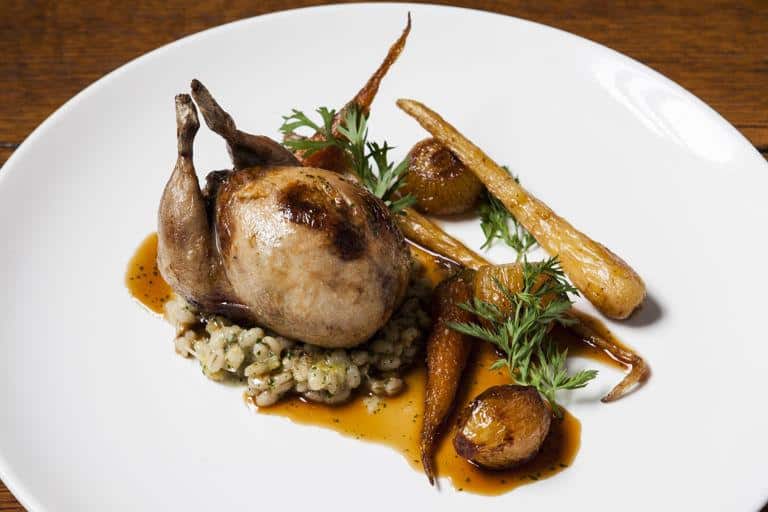
Quail is a small game bird known for its delicate flesh. It is enjoyed for both its eggs and meat. It offers a slightly gamey flavor and is highly prized in various cuisines.
- Origin: For centuries, quail has been hunted and consumed in Europe and the Middle East.
- Culinary Pairings: Often paired with earthy flavors like rosemary and mushrooms.
- Nutritional Information: A good source of lean protein and vitamins such as B6 and B12.
- Cultural Significance: A common sight in traditional European hunting dishes.
- Interesting Facts: Quail eggs are considered a delicacy and are often used in gourmet cooking.
4. Quail Eggs

Quail eggs are smaller than chicken eggs but are packed with flavor and nutrients. They are considered a delicacy in many parts of the world.
- Origin: Native to Asia, quail and their eggs have been consumed since ancient times.
- Culinary Pairings: Commonly used as a garnish on canapés or in sushi.
- Nutritional Information: Rich in good cholesterol, protein, and contain significant amounts of vitamin B1.
- Cultural Significance: In Japanese cuisine, quail eggs are commonly used in sushi and are known as “uzura tamago.”
- Interesting Facts: Quail eggs are said to have healing properties in traditional Asian medicine.
5. Quesadilla

A quesadilla is a Mexican dish involving a tortilla filled with cheese and sometimes other ingredients, then folded and grilled.
- Origin: The quesadilla has its roots in colonial Mexico, as a blend of native Mexican and Spanish foods.
- Culinary Pairings: Often filled with meats, vegetables, and spices, aside from the staple cheese.
- Nutritional Information: Caloric content varies depending on fillings but generally high in calcium from the cheese.
- Cultural Significance: A staple in Mexican street food and casual dining.
- Interesting Facts: The name ‘quesadilla’ literally means ‘little cheesy thing’ in Spanish.
6. Quark

Quark is a type of fresh dairy product, similar to cottage cheese but smoother, originating from Europe.
- Origin: Widely used in German-speaking countries and Eastern Europe.
- Culinary Pairings: Often used as a base for creamy sauces, in cheesecakes, or simply seasoned as a spread.
- Nutritional Information: Low in fat and high in protein.
- Cultural Significance: It is a staple in German kitchens, often used in desserts and breakfast dishes.
- Interesting Facts: Unlike most cheeses, quark is made without rennet and is completely natural.
7. Queso (Cheese)

Queso simply refers to cheese in Spanish, encompassing a variety of cheese types commonly used in Hispanic cuisines.
- Origin: Cheese-making in Spain dates back thousands of years, with each region developing its own varieties.
- Culinary Pairings: Used in dishes like nachos, enchiladas, and as a topping for beans.
- Nutritional Information: Varies by type but generally high in protein and calcium.
- Cultural Significance: Plays a critical role in Mexican and Spanish cuisines.
- Interesting Facts: The term ‘queso’ can refer to anything from fresh cheese like queso fresco to aged varieties like queso manchego.
8. Quahog
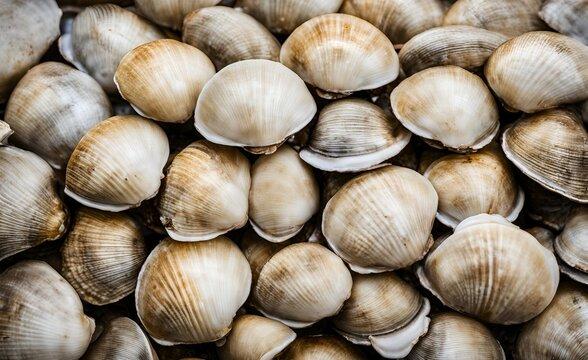
The quahog is a type of hard-shell clam, commonly found on the East Coast of the United States.
- Origin: Native to the eastern coast of North America, it has been harvested by Native Americans for thousands of years.
- Culinary Pairings: Often used in chowders and stuffings.
- Nutritional Information: A great source of lean protein, iron, and omega-3 fatty acids.
- Cultural Significance: Quahog shells were used to make wampum, a form of currency among Eastern Native American tribes.
- Interesting Facts: The oldest recorded quahog was estimated to be 507 years old when it was found in 2007.
9. Quince
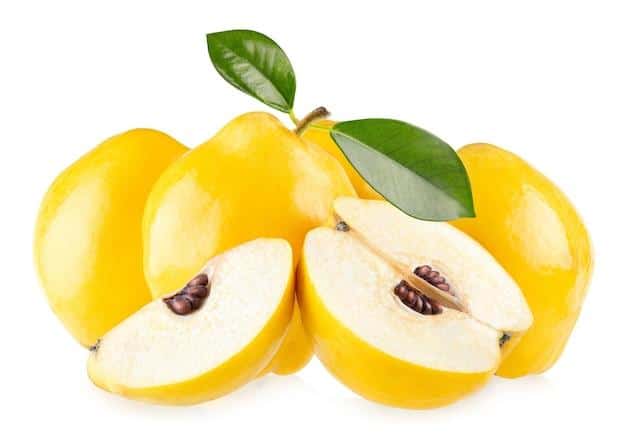
Quince is a pome fruit that resembles a pear, which is almost always cooked before eating due to its tartness.
- Origin: Native to the rocky slopes and woodland margins of Southwest Asia.
- Culinary Pairings: Commonly made into preserves, jellies, and used in pies.
- Nutritional Information: High in dietary fiber, antioxidants, and vitamin C.
- Cultural Significance: In ancient Greece, quince was a ritual offering at weddings, thought to be a sacred emblem of Aphrodite.
- Interesting Facts: The phrase “apple of my eye” originally referred to the quince, which was once believed to have prophetic powers.
10. Quaker Oats

Quaker Oats are a brand of oats known for their quality and versatility. They have become synonymous with breakfast cereals around the world.
- Origin: The Quaker Oat Company was founded in 1901 in the United States.
- Culinary Pairings: Used in baking, for making oatmeal or granola.
- Nutritional Information: Rich in fiber and protein, helping to reduce cholesterol levels.
- Cultural Significance: One of the first companies to use extensive advertising to promote oats as a breakfast staple.
- Interesting Facts: The Quaker name was chosen for its association with the qualities of good quality and value.
11. Quick bread

Quick bread includes any bread leavened with leavening agents other than yeast or eggs. Easy to make, they are a staple in many households.
- Origin: Emerged in the United States during the 18th century.
- Culinary Pairings: Often enjoyed with butter, jam, or used for sandwiches.
- Nutritional Information: Varies widely based on ingredients but generally high in carbohydrates and sugars.
- Cultural Significance: Became popular in America where bakers sought quicker methods than yeast-raised bread.
- Interesting Facts: Banana bread, a type of quick bread, became popular in the U.S. during the Great Depression.
12. Quince Cheese

Quince cheese, also known as dulce de membrillo, is a thick jelly made of quince fruit, sugar, and lemon juice. It is often paired with cheese or served as a dessert.
- Origin: This sweet originates from the Iberian Peninsula, where it has been a traditional dessert since medieval times.
- Culinary Pairings: It is typically served with manchego or other firm cheeses, creating a perfect balance of sweet and savory.
- Nutritional Information: Rich in carbohydrates and dietary fiber, low in fat.
- Cultural Significance: A staple in Spanish and Portuguese cuisines, often used during holidays and family gatherings.
- Interesting Facts: Quince cheese is known for its long shelf life, and when stored properly, it can last for several months.
13. Queen Scallops

Queen scallops are a smaller variety of scallops. They are known for their sweet flavor and tender texture, making them a delicacy in seafood cuisine.
- Origin: Found primarily in the shallow waters around the British Isles.
- Culinary Pairings: It is often paired with light dressings or sauces, such as garlic butter or a white wine reduction.
- Nutritional Information: High in protein and omega-3 fatty acids, low in fat.
- Cultural Significance: Frequently featured in British and Irish coastal cuisines.
- Interesting Facts: Queen scallops are usually harvested using environmentally friendly methods compared to other shellfish, promoting sustainable fishing practices.
14. Queso Dip
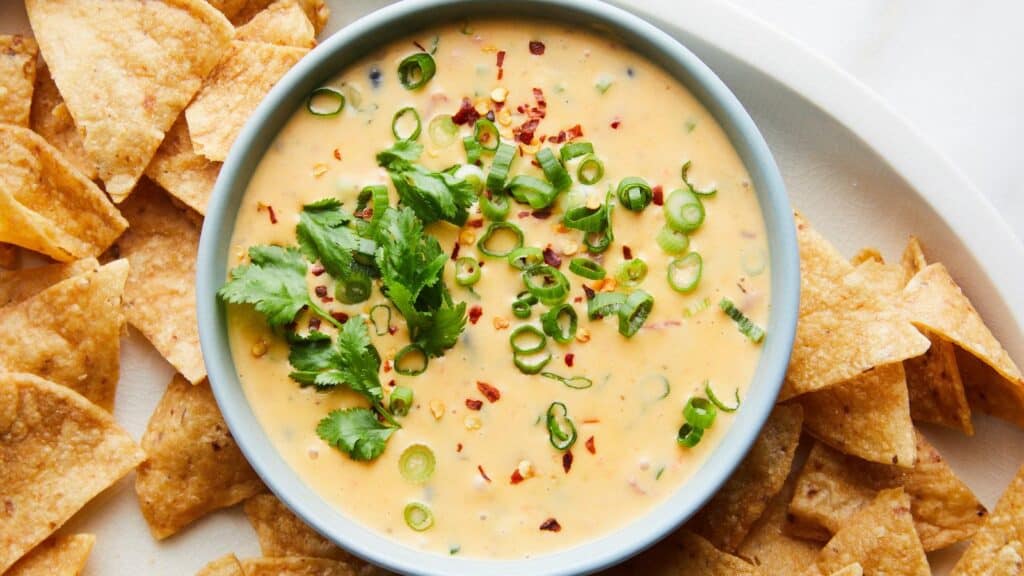
Queso dip is a melted cheese sauce, often combined with tomatoes, chilies, and spices, popular in Tex-Mex cuisine.
- Origin: The Tex-Mex version of queso dip originated in Texas, inspired by Mexican quesos.
- Culinary Pairings: Typically served with tortilla chips, used as a topping for nachos and tacos.
- Nutritional Information: High in calories and fat, particularly if made with cream and full-fat cheese.
- Cultural Significance: A favorite in American Southwestern cuisine, especially at parties and casual gatherings.
- Interesting Facts: The word ‘queso’ in Spanish simply means ‘cheese.’
15. Quenelle

Quenelle is a mixture of creamed fish, chicken, or meat, sometimes combined with breadcrumbs, with a light egg binding.
- Origin: Originated in France; traditionally, it involves poaching the finely ground paste into a delicate, oval shape.
- Culinary Pairings: Often served with a rich cream sauce or in a broth.
- Nutritional Information: Depends largely on the ingredients but is generally high in protein.
- Cultural Significance: A classic dish in French cuisine, showcasing the finesse of French cooking techniques.
- Interesting Facts: The term quenelle is also used in French to describe the shape of this dish, similar to an elongated egg.
16. Queso Flameado

Queso Flameado is a Mexican dish consisting of melted, flambéed cheese often combined with chorizo or another type of meat.
- Origin: Popular in Northern Mexico and the Texas region, embodying the festive spirit of Mexican cuisine.
- Culinary Pairings: Typically scooped with tortilla chips or stuffed into flour tortillas.
- Nutritional Information: High in protein from the cheese and meat, but also high in fat.
- Cultural Significance: Often prepared as a dramatic tableside presentation involving flambéing.
- Interesting Facts: ‘Flameado’ means flamed in Spanish, referring to the dish’s preparation method.
17. Quinoa Salad
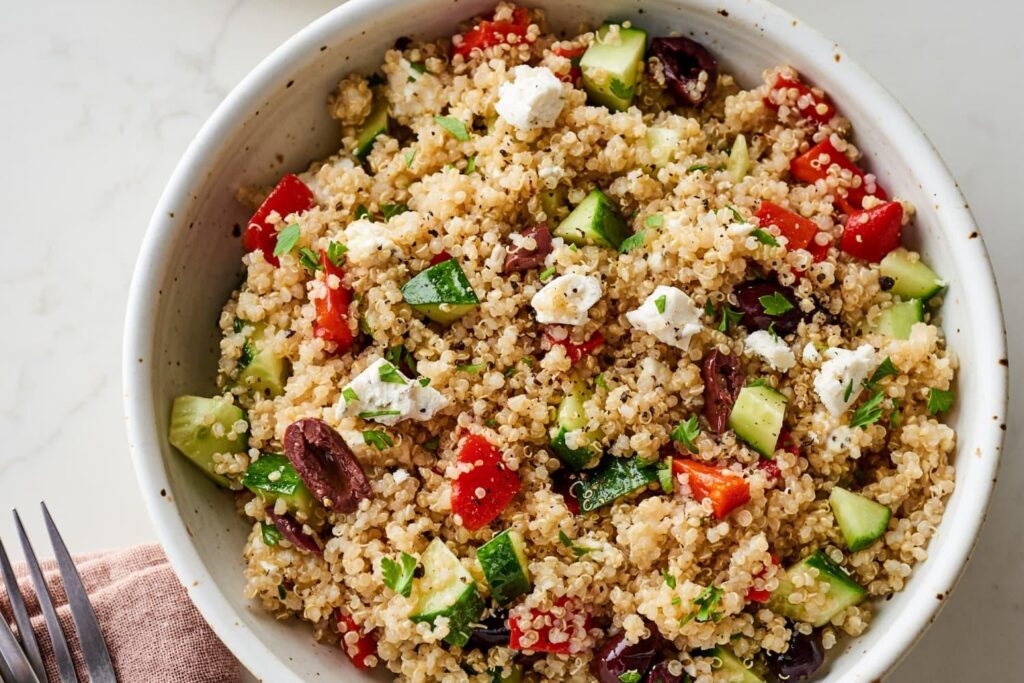
Quinoa salad is a healthy, refreshing dish made with quinoa and various mix-ins such as vegetables, nuts, and dressings.
- Origin: While quinoa itself is from South America, quinoa salad is a modern creation popularized by health-conscious eaters worldwide.
- Culinary Pairings: Works well with a mix of fresh vegetables, dried fruits, nuts, and a light vinaigrette.
- Nutritional Information: Rich in fiber and essential nutrients, making it a favored dish among those seeking a healthy diet.
- Cultural Significance: Reflects the global trend towards health-aware eating, incorporating ancient grains into modern diets.
- Interesting Facts: Quinoa was so valuable to the Incas that they referred to it as the “mother of all grains.”
18. Quorn (meat substitute)

Quorn is a meat substitute product originating from the UK, made from a fungus-based protein known as mycoprotein.
- Origin: Developed in the UK in the 1980s as a nutritious alternative to meat.
- Culinary Pairings: Can be used in place of chicken or beef in most recipes, ideal for stir-fries, curries, and as burger patties.
- Nutritional Information: High in protein and fiber, low in saturated fat.
- Cultural Significance: Gained popularity as a sustainable alternative to meat, appealing to vegetarians and environmentally conscious consumers.
- Interesting Facts: The main ingredient, Fusarium venenatum, was discovered growing in a soil sample in Marlow, Buckinghamshire.
19. Quark Yogurt

Quark yogurt is a creamy, soft cheese similar to yogurt. It is known for its smooth texture and mild tangy flavor, and it is often used in both sweet and savory dishes.
- Origin: Originates from Europe, which is particularly popular in German-speaking countries.
- Culinary Pairings: Commonly used as a base for cheesecakes, served with fruits or used in dips and dressings.
- Nutritional Information: High protein and calcium, with less fat than cream cheese.
- Cultural Significance: A staple in German, Austrian, and Eastern European diets, often included in breakfasts and desserts.
- Interesting Facts: Quark yogurt is known for its versatility in cooking. It can replace higher-fat dairy products in recipes without sacrificing texture.
20. Queen Olives

Queen olives, larger than most other varieties, are prized for their smooth texture and mild flavor, making them a favorite for eating whole.
- Origin: Predominantly grown in Spain, queen olives are harvested both for table eating and for oil.
- Culinary Pairings: Often stuffed with pimentos, almonds, or cheese, and served as appetizers.
- Nutritional Information: High in vitamin E and antioxidants, with a high content of healthy fats.
- Cultural Significance: Olives have been a significant agricultural product in Mediterranean regions for thousands of years.
- Interesting Facts: The name “queen olive” is an informal term reflecting the size and quality of the fruit.
87 Additional Foods Starting with Q
- Quail Pie
- Quinoa Burger
- Quail Eggs Benedict
- Quince Jam
- Quince Paste
- Quinoa Pasta
- Quail Egg Sushi
- Quarter Pounder
- Qatayef (Arabian dessert)
- Quince Jelly
- Quinoa Stew
- Quinoa Soup
- Quandong (Australian wild peach)
- Quince Cake
- Quince Tart
- Quinoa Risotto
- Quail Egg Salad
- Quark Cheese Pie
- Quince Stew
- Quark Pancakes
- Quaker Rice Cakes
- Queen of Puddings (British dessert)
- Quinoa Flakes
- Quinoa Porridge
- Quinoa Bowl
- Quindim (Brazilian dessert)
- Quinoa Tabbouleh
- Quattro Formaggi Pizza
- Quail Egg Omelet
- Queso Relleno
- Queen Anne’s lace (edible wild carrot)
- Quince Sauce
- Qubani ka Meetha (Indian dessert)
- Quiche Lorraine
- Quince Compote
- Quark Cake
- Quenepa (Spanish lime)
- Quince Sorbet
- Quick Pickles
- Qottab (Iranian pastry)
- Quarterback Crunch (ice cream)
- Quiche Florentine
- Quorn Fillets
- Quinoa Cereal
- Quail Egg Tart
- Quiche Provencal
- Quail Egg Pad Thai
- Quenelle of Pike
- Quail with Rosemary
- Quiche with Goat Cheese
- Quail Curry
- Quatre épices (French spice blend)
- Quail Biryani
- Quinoa Bread
- Quinoa Cookies
- Quinoa Crackers
- Quinoa Chips
- Quinoa Pancakes
- Quinoa and Black Bean Burger
- Quail Egg Custard
- Quail Egg Canapés
- Quahog Chowder
- Quark Cheesecake
- Quinoa Chocolate Cake
- Quince Marmalade
- Quaker Granola
- Quinoa and Beet Salad
- Quinoa and Vegetable Stir Fry
- Quinoa and Chickpea Salad
- Quince Wine
- Quinoa and Avocado Salad
- Quail Egg Quiche
- Quail Egg Pizza
- Quail in Puff Pastry
- Quail and Pea Shoots Salad
- Quark with Herbs
- Quiche with Spinach
- Quince Water
- Quaker Corn Bran
- Quinoa Muffins
- Quark Dumplings
- Quince and Apple Crumble
- Quail Egg Crostini
- Quince Vodka
- Quahog Stuffed
- Quick Yeast Bread
- Quinoa Pudding
Summing Up
We’ve ventured through diverse foods that begin with ‘Q,’ each offering unique flavors and culinary experiences.
From the everyday quinoa to the less common quenepa, this list broadens your dietary palette and invites you to explore global cuisines right from your kitchen.
Now that you’re familiar with these interesting options, why not choose a few to incorporate into your next meal plan?
Whether you’re cooking for comfort or adventure, these ‘Q’ foods are ready to transform your culinary routines.


















